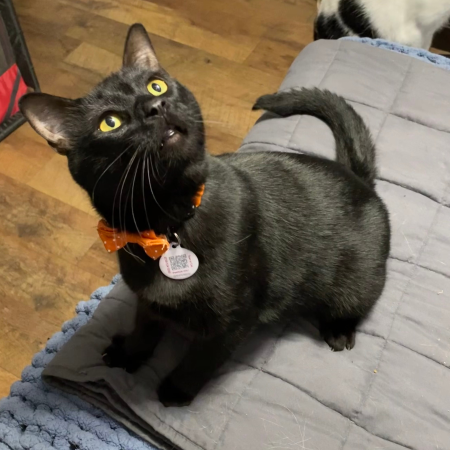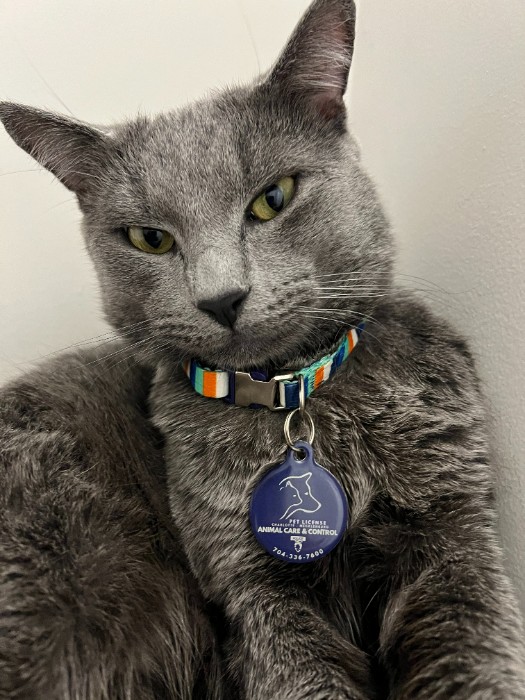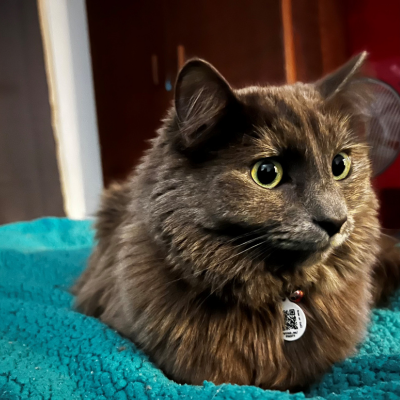Cats seem to be natural escape artists. They somehow manage to squeeze their flexible bodies into, and out of, all sorts of confining spaces, including gates, fences, and other obstacles. Sometimes they even manage to tree themselves! (Having this issue? Try this gate.) Unlike their canine comrades, cats are also slightly more independent, and tend to remain outside long after Fido has found his way home.
In order to give them a better chance of being found, or rescued, if need be, make sure that your cat is wearing a collar. There are a number of different collars like these on the market, so choosing one that suits owner and cat is just a matter of taking the time to shop around. Most pet stores even welcome their feline customers if properly leashed or otherwise secured.

While an attractive collar is nice, the whole point of having one is to make sure that you can be reunited with your feline friend should he or she ever wander off. For that to happen, the owner’s information should be clearly written or imprinted on the tag. Obviously, you wouldn’t put all of your personal information on a cat’s collar, but a cell, home or office phone number and a last name are usually enough to enable someone to contact you if they find the animals wandering around their neighborhood, or should it be picked up by an animal control officer.
You may also want to consider purchasing a personalized collar for your cat. These are often made of leather, rubber or nylon, and can have the owner’s name and contact information imprinted or studded onto it.
Adding a reflective strip of fabric to the collar will also help in case the cat makes its escape at night. Cats have excellent night vision, but unfortunately humans are less well equipped to see well in darkness. Therefore, a reflective band can save all but the most suicidal of cats from being injured or killed. Another great option for keeping tabs on your cat is to get them a pet monitor from Whistle. Whistle has multiple monitors that can be attached to your cat’s collar and also works as a cat fitbit-type monitor their health.
With any collar, be sure that proof of a rabies vaccination is displayed somewhere on your cat’s tag. You may want to consider an all-in-one ID tag such as PetHub's Digital Pet ID. This tag allows you to store all your cat’s information in a free, online profile that anyone can access by either scanning the QR code on the back with a smartphone, typing in the unique web address, or calling the toll-free hotline number on the tag. Storing the information in your cat’s profile also allows you to update it at any time and from anywhere with an Internet connection, including sharing your contact information should your cat go missing.
Most of the cat collars available today also include a breakaway panel somewhere on the collar for safety. If the cat should find itself hopelessly entangled, that particular section of fabric will give way, allowing the cat to free itself. This is an important feature to look for when considering a collar, as it can prevent the cat from injuring or strangling itself trying to pull loose from bushes, fence panels and other obstacles. If your cat is smart enough to learn how to release the panel, you may want to look into a collar that has a durable, yet easy to cut fabric.
 For maximum protection, you may wish to consider purchasing a GPS collars or radio collar. The collars work the same way the GPS system in your car does; sending a signal to a monitoring station that allows the cat’s position to be determined, and its movement monitored. Unfortunately these collars are rare in the U.S., bulky, and include a monthly monitoring fee. An alternative is the radio collar, which is smaller, lighter, and more readily available, but does not provide the exact location, but does give the owner a general idea of the cat’s area. They are also more limited in range, and may not successfully locate a lost cat.
For maximum protection, you may wish to consider purchasing a GPS collars or radio collar. The collars work the same way the GPS system in your car does; sending a signal to a monitoring station that allows the cat’s position to be determined, and its movement monitored. Unfortunately these collars are rare in the U.S., bulky, and include a monthly monitoring fee. An alternative is the radio collar, which is smaller, lighter, and more readily available, but does not provide the exact location, but does give the owner a general idea of the cat’s area. They are also more limited in range, and may not successfully locate a lost cat.
For the fashionable cat owner, there are a number of decorative collars available, ranging in price from a few dollars to more than $1500. Styles vary from the simple leather collars to those decorated with simple beads, sequins and faux fur all the way to high end collars that sport rhinestones, Swarovski crystals or even tiny diamonds! For pet owners who enjoy parading their cat on a leash, remember that the collar is there to provide information, not to attach the leash to. Doing so can result in serious spinal injuries to the cat, should they pull or struggle against the leash. Special harnesses can be purchased for walking cats.
Of course, none of these collars will do any good unless the cat is wearing it, so take plenty of time to ensure that the collar fits comfortably on the animal’s neck. A collar that is too tight can be uncomfortable at the least, and in a worst case scenario can severely restrict the blood and air supply, while a collar that is too loose is likely to get caught on all sorts of objects, or slip off completely. An ideal fit allows 1 to 2 fingers to slide beneath the collar.

If you just can’t get your cat to stay in its collar, you may want to look into having the animal microchipped. This involves inserting a chip about the size of a pin under the animal’s skin, where it remains. Each chip carries a unique identifying number, and is stored in a national database with the contact information for the owner. This will not make contacting the owner immediately possible, but most veterinary offices and animal control facilities are able to read microchips if they have the correct reader.

